|
1999-2004 (Return to Web Text-ures) |
Click Here to return to |
III.
BEACON HILL
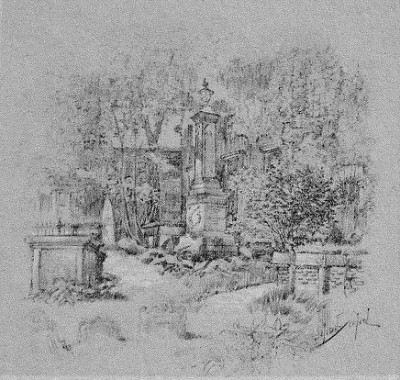
KING'S CHAPEL BURYING GROUND, LOOKING TOWARD TREMONT STREET;
RESTING PLACE OF JOHN WINTHROP,
FIRST GOVERNOR OF THE MASSACHUSETTS BAY COMPANY, AND MANY OF THE EARLY
BOSTONIANS; THE FIRST BURIAL PLACE IN BOSTON.
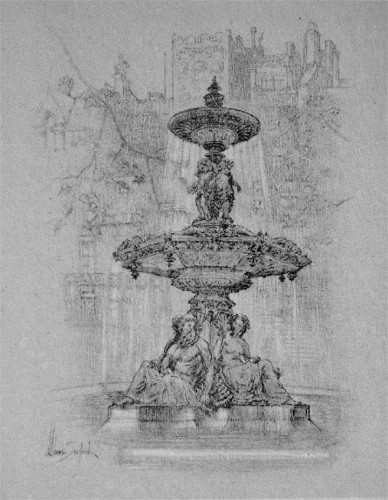
THE BREWER FOUNTAIN ON BOSTON COMMON, BEACON HILL
SLOPE.
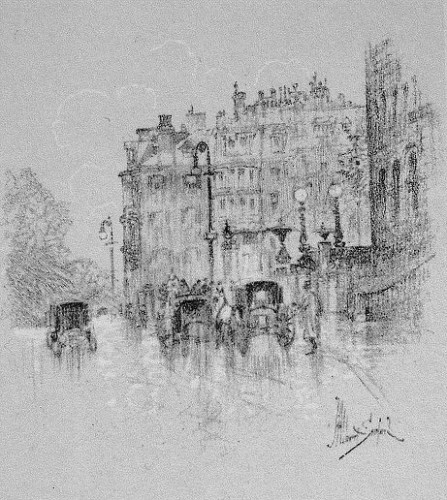
TOP OF BEACON STREET NEAR THE SITE OF THE HANCOCK HOUSE,
WHERE
LIVED GOVERNOR JOHN HANCOCK AND HIS WIFE, DOROTHY QUINCY.
GOVERNOR Winthrop and the Puritan founders of Boston spent their first Massachusetts summer, 1630, in Charlestown, where the climate and the drinking water combined to cause serious illness and, in many cases, death. In the hot afternoons they used to gaze longingly across the Charles river at the three-peaked top of Shawmut promontory, where the Reverend William Blackstone made his home. He had cool drinking water from numerous springs that flowed mysteriously out of the hillsides; and there was usually a pleasant breeze to temper the summer heat. It occurred to Blackstone that the broad slopes of Shawmut offered promising opportunities for development, so he suggested something of the sort to Winthrop. Accordingly, in early autumn, the governor and his flock moved over. Winthrop eventually located at the point today occupied by the Old South building. They say Mistress Winthrop went daily with her bucket to a spring a little farther east where now you find "Spring Lane," a thoroughfare that has maintained its ancient identity to this day, while the fount itself is said to flow seaward, through a subterranean channel.
In 1633 the Town of Boston set aside for William Blackstone fifty acres of farm and woodland. Blackstone's home was in the vicinity of the present Louisburg square. Where today the dignified old streets on the western slope of Beacon Hill drop sedately down towards Charles River Basin, he raised apples and roses. Blackstone has been called the "First Inhabitant" of Boston, and some have referred to him as the "Hermit of Shawmut." Oxford bred, and in the neighborhood of thirty-five years old, one wonders how this shy young clergyman found courage to leave home and take up a solitary life in the wilderness, and why. He must have been a sort of Puritan Robinson Crusoe.
The Winthrop party found him "monarch of all he surveyed," a frockless pastor, preaching tender sermons of friendliness to the wild creatures and living the simple life alone among his orchards and rosebushes. When the newer settlers had built their houses and established town government and a market, Blackstone used to ride over from home on a steer, broken to saddle, to chat with the townsfolk, and to do a little shopping. No doubt a pleasant spoken young bachelor found it easy to get a few stockings mended or a button sewed on. He was certainly entitled to some consideration, since he had been unquestioned proprietor of the seven hundred acres of dry land on Shawmut promontory.
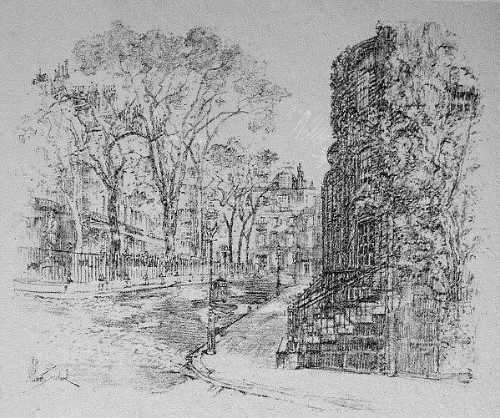
LOUISBURG SQUARE; BLACKSTONE'S SPRING ONCE FLOWED HERE; AT
NUMBER TEN LIVED LOUISA M. ALCOTT;
AT NUMBER FOUR, WILLIAM DEAN HOWELLS; JENNY LIND WAS MARRIED, IN 1852, AT NUMBER TWENTY.
Some vision of the future growth of urban Boston prompted the town fathers to look twice at the acreage allotted to Blackstone, for within a year they bought all but six acres back from him for one hundred and fifty dollars, and reserved it as a "common" for pasturage, and a "training ground." In 1640 the town decided that no portion of it should ever be granted to an individual for homestead or garden.
On or near the Blackstone property on West Hill, later lived Copley, the painter, John Phillips, first Mayor of Boston, John Lothrop Motley, the historian, the Reverend Doctor Channing, and the patriots Otis and Prescott. Much of West Hill -- or Copley's Hill -- one of the original three knolls that gave the height its name, Tri-mount (Tremont) was dug away to help extend the dry land at the edge of Back Bay and make possible the building of Charles street.
On the eastern slope of another of the three peaks dwelt the Reverend John Cotton, and with him, for a time, Sir Henry Vane, "boy governor" of the Massachusetts Bay Company at twenty-four. Sir Henry presently went back to England, where, in time, he died violently from too much mixing of religion and politics. Cotton Hill, later called Pemberton Hill, was, like the other two peaks, dug away in time.
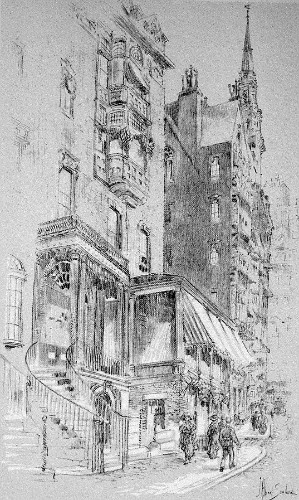
PARK STREET; AT THE EXTREME LEFT, TICKNOR HOUSE, 1804.
LODGINGS OF LaFAYETTE IN 1824.
ONCE THE HOME OF GEORGE TICKNOR, THE HISTORIAN. BEYOND, THE SPIRE OF
PARK STREET CHURCH.
Park street, as we know it, came in 1640 by the name of "Centry" or "Sentry street," and led up to the third, or "Sentry Hill," which stood some six or seven score feet above harbor level. About this time the powers back home talked of lifting the Massachusetts Bay Company's charter, but when demand was made for it, shrewd John Winthrop fashioned sundry excuses, to wit, he had lost the key to his desk, or had mislaid the document, or some such sufficient cause of delay; and meanwhile, against the day when the King should send an armed agent to require the charter, the colonists set up a "beacon" on the height -- a sort of mast, --with a great suspended kettle near the top, and rungs to climb it withal. Guards watched the ocean for the mastheads of unfriendly ships, and planned to kindle a fire, not under, but in the kettle, to warn the countryside. But so long as the beacon stood -- certainly until 1789 -- no alarm fire is recorded.
Charles Bullfinch, architect of our present State House, designed a monument to replace the old beacon, and this was set up in 1790, and stood until 1811, when "somebody moved the hill." It ought not to have been done, but gravel was at a premium. On July 4, 1795, the corner stone of the new State House was laid with Masonic ceremonies and when the monument came down its memorial tablets were filed away in the State House basement. Later, public spirit reincarnated the monument and set the tablets in its base. It stands today on a spot, which, in everything but altitude, corresponds with the location of its original.
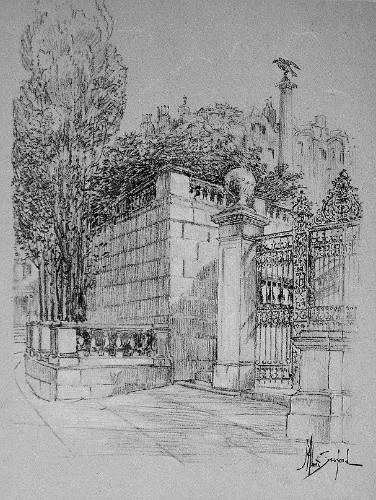
DERNE STREET TERRACES OF THE STATE HOUSE, BEACON HILL. TOP
OF THE BEACON MEMORIAL,
SET UP TO COMMEMORATE THE OLD BEACON OR "CENTRY."
House-lot prices languished in those early years on "Tri-mount." One would hardly care to build on a lot while one's next neighbor industriously dug and hauled away his land to help fill up a Mill Pond or a Great Cove, until one's home stood on the verge of a gravelly precipice. Beacon (Sentry) Hill so long as it stood constituted a commanding lookout. Here came the people in crowds to watch Lord Percy's honey-combed battalions trail back over the distant roads into Charlestown, after "A Day in Concord and Lexington," April 19, 1775. Here a few weeks later, June 17, the same throng stood with strained and anxious eyes to note the powder-and-bayonet argument on Breed's Hill and the burning of Charlestown. In those days, too, the early "seeing-America-first" enthusiasts admired Massachusetts Bay from the foot of the beacon, and compared it with the well-known bay of Naples, to the great disadvantage of the latter.
John Hancock, supposed by many young persons to be the inventor of the autograph for use in the manufacture of Important Documents, lived magnificently on Beacon Hill in a house built by his uncle, Thomas Hancock, in 1737, one of the earliest, if not the first, of the more pretentious edifices in the vicinity.
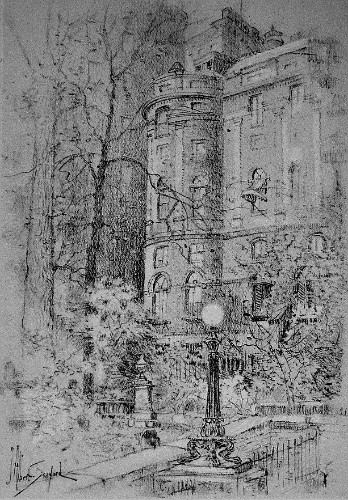
REAR OF THE ATHENAEUM, OVERLOOKING OLD GRANARY BURYING
GROUND. BUILT AS A GALLERY AND LIBRARY.
CONTAINS MANY RARE BOOKS AND COLLECTIONS, INCLUDING A LARGE PART OF GEORGE
WASHINGTON'S
PRIVATE LIBRARY. A FAMOUS LITERARY CENTRE.
It was the executive mansion from 1780 until 1793, excepting two years, for John Hancock became first constitutional governor of Massachusetts. Efforts to preserve the old house were unavailing, and it was demolished, to be replaced by modern dwellings, after having stood considerably over a century.
In the face of the development of the Back Bay as a select residential section, most of which has taken place in the last fifty years, Beacon Hill today retains its fine distinction, both of aspect and atmosphere. There is always a certain scorn among hill people for dwellers upon low ground. Heed the words of the father of Phillips Brooks, who, himself but recently come thither, wrote in 1868, in a letter to his distinguished son:
"It is an old house and there is a good deal to do to it. It is one you will feel just as much at home in as at High street or Chauncy street. Nothing 'stuck up' about it; like all our other houses, neat but not gaudy; not like the houses on the Back Bay, where the people go out in the morning to find the doorsteps have sunk out of sight; but it is on the solid hardpan of Beacon Hill, original soil; street named from the old John Hancock."
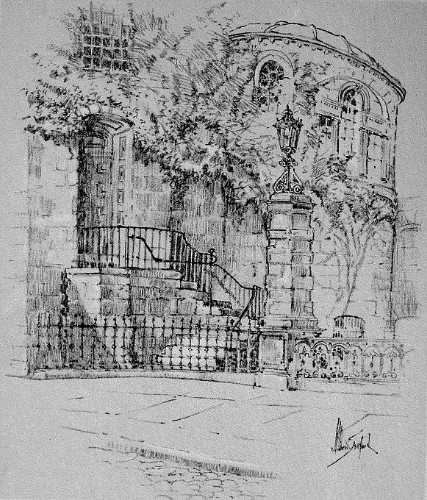
REAR OF KING'S CHAPEL, SCHOOL STREET, BUILT IN 1754,
THE OFFICIAL CHURCH OF THE ROYAL GOVERNORS IN
PROVINCIAL DAYS. THE FIRST KING'S CHAPEL, ON THIS
SITE, WAS THE FIRST EPISCOPAL CHURCH IN NEW ENGLAND;
NOW UNITARIAN.
Click the book image to continue to the next chapter
